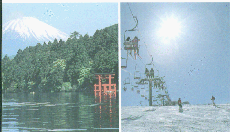 Mt. Fuji and ski resorts
Mt. Fuji and ski resorts
Hot-spring resorts, seaside resorts, ski and other recreational resorts make Japan a country active in land and water sports. From the highland resorts of Hakone and Karuizawa to the ocean beaches of Izu and Okinawa, pleasure in active leisure characterizes the Japanese people.
Domestic cuisine is another kind of delight. From the grids of countryside rice paddies to the nets of fish and seafood drawn from ocean waters, the basic need for sustenance has, through the centuries, led to food preparation and service raised to the status of a fine art. Even the most modest dishes appeal to the eye as well as the appetite. Sushi, pot stews, tempura, skewered chunks of chicken, bowls of noodles, deftly blended soups and delicate teacups --- all attest to a fond Japanese devotion to the visual aftraction of food and drink.
Japan is both old and new, and the two aspects of its culture coexist in a benign environment. An "intelligent" office building, the epitome of modern Japan in the so called information age, may have a tiny Shinto shrine on its roof as a testament to traditional beliefs and values that do not die out. The splendid achievements of Japan's classical arts and architecture are preserved with pride, as seen in Nikko, Kamakura, Kyoto, Nara and Kanazawa. The towers of feudal castles still dominate some cityscapes, the most famous being the Heron Castle at the center of Himeji City. Pavilions and teahouses breathe the past into the present amid the verdant vistas of classic landscape gardens, most notably at the Katsura Detached Palace in Kyoto. The nation's preoccupation with robotics, super-computers and industrial dreams for the future does not conflict with its deep-seated devotion to the tea ceremony, flower arrangement, or other traditional arts and crafts. Although small in total land area, the country is big enough to accommodate the newest genres of music and drama side by side with Noh, Kabuki and the Bunraku puppet show.
A special charm of Japan is its tradition of courtesy and hospitality. The deep bow of greeting, the shout of "Irasshaimase!" as guests enter a restaurant, the tea and sweets served on a visit to a private home, all carry forward through time a warm-hearted cordiality that is age-old.
Celebration is another key component of the Japanese mentality. The world's fastest bullet trains speed millions of Japanese from the big cities to ancestral hometowns to celebrate the New Year and summertime Bon festival. Festivals are, in fact, prominent events in most parts of Japan throughout the four seasons. Their origins often shrouded in prehistory, they persist as reminders of long-cherished values. Cherry-blossom viewing parties in early spring and autumn foliage outings represent a close identification of human happiness with the graces of nature. Spring also brings with it shrine festivals in which portable shrines are carried through the streets on strong shoulders, including Tokyo's Sanja Matsuri the 3rd weekend in May, and the spectacular feudal procession at Nikko's Toshogu Shrine. Summer is memorable for the Gion Matsuri parade in Kyoto on July 17, Sendai's Tanabata Matsuri on August 7, and the Nebuta or Neputa festivals in Aomori and Hirosaki at about the same time. Fall is time for festive events that range from Nagoya's civic celebration in mid-October to Kyoto's historic Jidai Matsuri and Fire Festival, both on October 22. Winter snows lend a special element to Sapporo's snow-sculpture Snow Festival over February 5-11 each year. It's also the season for citizens of northern Akita Prefecture to build celebratory snow huts in mid-February and for hundreds of youths in loincloths to fight for possession of a sacred wand at the Saidaiji Temple in Okayama City on February's 3rd Saturday.
Whatever you have in mind as you plan a vacation trip to Japan, rest assured that you are coming to a country that cherishes its past as much as the present and future, its natural aftractions as much as its man-made achievements. That is one of the myriad aspects of Japan that make it so enchanting no mafter when and where you choose to enjoy its infinite charm.